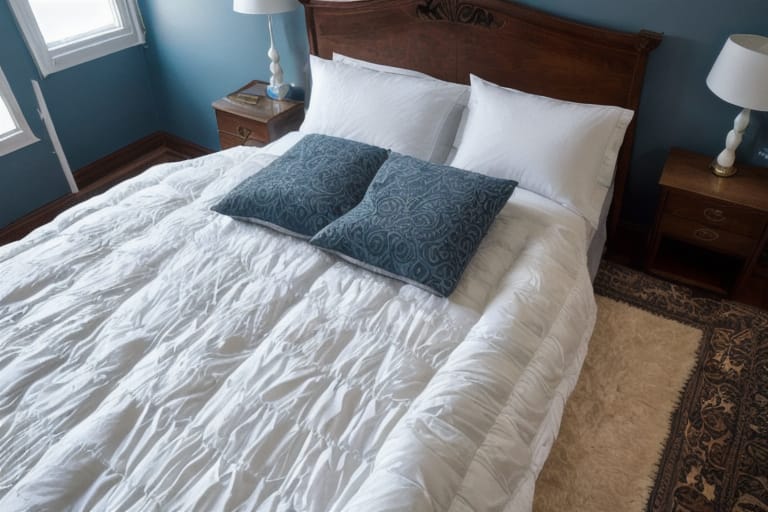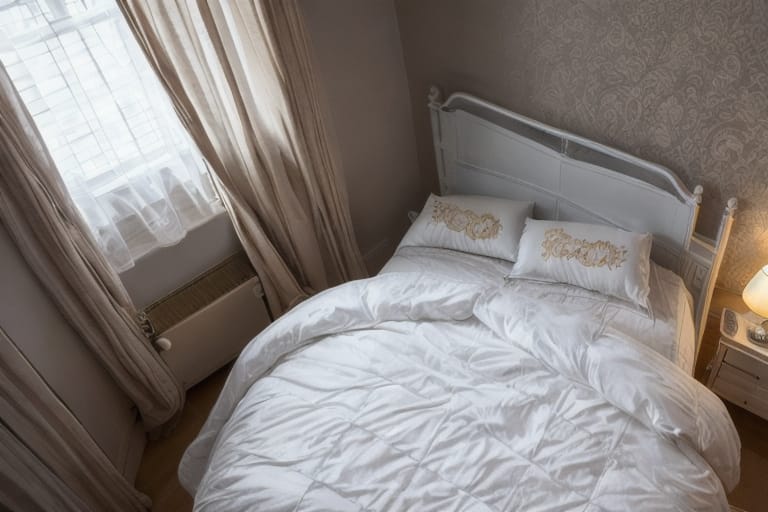Goose down comforters have graced beds for centuries, providing sleepers with a warm, lightweight, and supremely comfortable sleeping experience. But what exactly defines these luxurious bedding essentials? This beginner’s guide explores what does goose down comforter mean, explaining the composition and key benefits that set them apart.
We’ll cover everything from the structure of down to proper care and cleaning methods. You’ll also find unbiased recommendations of the best down comforters available today so you can find your perfect match! Whether a longtime fan of featherbeds or new to the wonders of goose down, read on to become a comforter connoisseur!
A Fluffy Introduction to Down Bedding
Before delving into goose down specifically, let’s review the basics of down bedding in general.
- Down refers extremely soft, fluffy plumage underneath the tougher exterior feathers of ducks and geese. It traps body heat, providing excellent insulation.
- Feathers have interlocking barbs and barbules that make them firmer. They are arranged in rows on the exterior to help birds fly.
- Down clusters are light, lofty bunches of thousand of tiny fibers that cling together. Their 3D structure gives them superior resilience and durability.
- Fill power is the measurement of space one ounce of down occupies in cubic inches when fully lofted up. Higher fill = better insulation from a lighter weight comforter.
Now that we’ve covered the basics, let’s move on to discuss the incredible coziness of goose down specifically!
The Warmth and History of Goose Down
Goose down comforters provide matchless levels of softness and breathability unmatched by any other fill types. Let’s explore what gives them their trademark cloud-like quality:
- Goose down comes from fully mature geese during their molting seasons when they naturally shed older feathers. The large size of geese means greater insulation than smaller duck down.
- European white goose down has the largest clusters that maximize lofting power and durability over time.
- Eiderdown from rare eider ducks produce down with the highest fill ratings – over 1200! But their extreme scarcity makes them costly.
- Goose down’s natural moisture-wicking keeps sleepers warm yet dry by allowing water vapors to pass through unlike synthetic fills.
Rich in history, filling comforters with goose down began in the chilly regions of Hungary and Poland, where subzero winters demanded superior bedding for warmth. Still handmade today using Old Word techniques, Hungarian goose down remains the gold standard worldwide.
Now that’s we’ve established the origins and advantages of goose down, let’s uncover exactly how professionals evaluate and grade this luxury bedding material.
Assessing the Quality of White Goose Down
As you set out to find your dream down comforter, it’s key to understand how to recognize truly superior fill through these key markers:
- Fill power: This indicates the “fluffiness” and insulation capacity provided. Most quality comforters now boast fill ratings between 600-900. Here’s a breakdown:
- Mature clusters: Down with larger, fuller clusters loft better and last longer than broken bits. Cluster strands should have smooth, kink-free fibers under a microscope.
- Odor and color: Fresh goose down has a clean scent and bright white coloration. Yellow, gray, or foul smelling stuff contains oil and dirt that lowers fill ratings.
- Downproof stitching: Tiny holes allowing fill escape means you’ll eventually have a flat, worthless comforter no matter how nice the interior fills starts. Check that outer fabric has tight, reinforced stitching with high thread count cotton shells.
Independent RDS certification also verifies bird sources and materials meet high ethical and safety standards for extra peace of mind.
Comparing Goose Down Varieties
Not all down gets created equally. Connoisseurs agree European white goose down certified as RDS compliant ranks as the pinnacle. But what sets it apart from the flock?
- Goose down generally surpasses duck down with larger clusters and better loft.
- European geese live free range in cold climates yielding high fill powers up to 900+ with near-perfect resilience.
- Hungarian down specifically has a reputation for unmatched longevity and durability over decades.
- Snow-white geese down offers pure color signalling meticulously hand sorted fills without quill shafts or debris.
- $50-70 per ounce reflects top-tier status but delivers lifetime value for unbeatable luxurious comfort.
By contrast, lower price but less exceptional varieties include:
- Chinese goose down with mixed small, broken clusters and average fill rating 500-600.
- Grey goose down has more odor and fill inconsistencies despite same species origins.
- Duck down with generally smaller clusters limiting lofting compared to premium goose.
While still decent options, these cannot match the enduring performance of Hungarian white goose down comforters. So check labels to source the good stuff for a fluffy investment.

Shopping Guidance for the Best Goose Down Comforters
Ready to dive under your personal perfect goose down comforter? Follow this helpful buying checklist:
- Intended use: Pick warmth for cold regions, lightweight for warmer climates, oversized for those who love burying themselves under bedding.
- Fill power: Consider 600-900+ for the best balances of cozy insulation and reasonable pricing in most households.
- Fill weight: Heavier isn’t always better for warmth. Focus instead on quality fill density you need – lighter in southern states, heavier in northern.
- Fabric shell: Downproof 100% cotton with 300+ thread count optimizes both coziness and durability.
- Certifications: Seek Responsible Down Standard (RDS) chain of custody proof.
- Ethics: Select reputable brands that avoid live-plucking and force-feeding methods.
- Price: Expect to invest $200+ for decent quality, $500+ for elite Hungarian white goose down.
Here are your best bang-for-buck options to start snuggling under supreme coziness:
1. Royal Bedding Goose Down Comforter
- $220-340 depending on size
- 650+ fill power
- RDS-certified Hungarian white goose down
- 500 thread count cotton
2. Basic Beyond Superior Goose Down Comforter
- $160-290 depending on size
- 600 fill power
- 30 oz fill weight
- 300 thread count cotton cover
3. Puredown White Goose Down Comforter
- $99-199 price range
- 550 fill power
- 100% cotton cover
- Beginner’s budget pick
Claiming superiority in the quest for that perfect fluffy experience takes some savvy, but rest assured your goose down comforter bliss awaits!
Proper Care and Cleaning of Goose Down
You invested in elite quality down bedding. Now learn how to maintain that delicate softness, lofting and longevity through proper home care:
- Cleaning method: Delicate home wash cycles or professional dry cleaning avoid damage. NEVER bleach – it weakens fibers!
- Drying care: Low heat tumble drying restores fluffiness so comforters fully re-loft after washing.
- Clump smoothing: Regularly massaging prevents insulation gaps from down shifting.
- Air exposure: Rotating and periodically airing out comforters keeps down fresh and bouncy.
- Storage: Use breathable cotton cases allowing air flow to prevent mildew or moth damage during off-seasons.
While pricier than other bedding types initially, properly cared for goose down comforters should bubble with cozy luxury for over 20 years!
Follow those simple guidelines and preventative measures and you’ll enjoy counting sheep under the sensuous billows of your goose down for decades to come. Pleasant dreams!
Goose Down vs Synthetic Comforters Comparison
For allergy sufferers or vegans, synthetic options mimic the lightweight insulation of featherbeds. But how well do these animal-free alternatives stack up? Judge by the key metrics that matter most:
Warmth
- Goose down clusters trap more body heat thanks to unbeatable lofting power.
- Synthetics like polyester insulation compresses more easily over time, losing out long-term.
Breathability
- Natural down allows excellent moisture wicking crucial for temperature regulation.
- Most synthetics retain more humidity although newer performance textiles improving.
Durability
- With proper care, white goose down maintains superior resilience over decades.
- Polyester breaks down faster, losing warming capabilities after just a few years.
Value
- Goose down comforters deliver more years of everyday luxury to justify higher initial investments.
- Synthetics satisfy temporary uses like camping for a fraction of the price.
While more budget-friendly, synthetics simply can’t provide lasting performance on par with the unbeatable insulation of fine goose down bedding. When your comfort counts, only the real deal will do for delivering nightly cozy bliss!

Frequently Asked Questions About Goose Down Comforters
Q: Why does a goose down comforter cost so much more than synthetics or even other down types?
A: European white goose down represents the world’s finest quality filling. Larger clusters, higher lofting ratios of fill/oz, and greater resilience means superior insulation over decades – not just years – thereby justifying the bigger investment for a worthy heirloom-quality luxury comforter.
Q: How can I add lightweight warmth options to my goose down comforter for extra coziness?
A: Layer goose down mattress toppers or duvet inserts under your favorite comforter for customizable cushy softness to any desired thickness. For more trapped body heat, adding flannel sheets or even electric warming pads can boost your overall warmth without sweating.
Q: What’s the benefit of baffle box stitching I see on some goose down comforters?
A: This quilting method divides fills into smaller chambers spread evenly across the comforter surface. This helps fills stay evenly distributed instead of shifting around unevenly. Although more expensive to produce, baffle boxes promote consistent insulation so no cold spots!
Q: Can I bring my goose down comforter when traveling or camping?
A: Portability makes synthetics more convenient for roughing it. For a down comforter’s fragile fibers vulnerable to dirt or moisture damage, it’s best keep them enjoying the comforts of home. Consider more durable wool blankets for overnight adventures instead.








